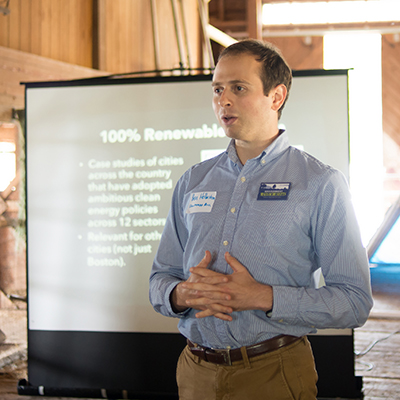
Ben Hellerstein
Former State Director, Environment Massachusetts
Last Friday, the Trump administration released the 2018 update to the National Climate Assessment. This year’s update focuses on the effects of a changing climate on human well-being, our society, and our environment.
Former State Director, Environment Massachusetts
Last Friday, the Trump administration released the 2018 update to the National Climate Assessment.
Under a 1990 law, the federal government is required to produce a report every four years summarizing the latest science on the impacts of global warming. This year’s update focuses on the effects of a changing climate on human well-being, our society, and our environment.
While the day after Thanksgiving is typically a slow news day, the report was covered widely in the media. Many of the stories drew a connection between the wildfires that have raged across California in recent weeks (and were only fully contained by firefighters on Sunday) and the increased likelihood of fires in a warming world. As the report describes, twice as much land in the western United States was burned by wildfire between 1984 and 2015 as would have been burned without climate change.
Less attention was paid to the report’s predictions of global warming impacts in the Northeast. In many ways, the Northeast is especially vulnerable to the effects of global warming. By 2035, average temperatures in the Northeast are expected to be more than 3.6 ºF higher than during the preindustrial era — the largest temperature increase in the contiguous United States. Along the coast between North Carolina and Massachusetts, sea levels have risen three to four times faster than the global average so far.
Here are some of the key findings for Massachusetts and other states in the Northeast:
Forests: As temperatures increase, warmer weather will arrive earlier and continue later in the year. As a result, insects that damage trees, including emerald ash borers, will likely emerge earlier in the year and expand their geographic range. Some of New England’s iconic woodland animals, like moose, are already experiencing more parasite infections and deaths from tick-borne illnesses because of warmer temperatures.
Maple syrup: Changes in climate will affect the quality of maple sap, the timing of maple syrup production, and the survival of maple trees.
Snow: As winter temperatures rise, we’ll see less of our precipitation fall as snow and more fall as rain. The snow we do get will stay on the ground for fewer days. That’s a big problem for the winter recreation industry, which generates $2.6–$2.7 billion in annual revenue in the Northeast. Some ski areas will compensate for the lack of snowfall with artificial snowmaking, but others will be unable to adapt.
Ocean wildlife: Warming oceans are affecting the range and abundance of marine wildlife. As scientists and the fishing industry have already observed, species like Atlantic cod and lobsters are shifting north. If we continue to emit large amounts of global warming pollution, about 50 percent of the commercial, forage, and protected fish and invertebrate species on the Northeast continental shelf will be “highly” or “very highly” vulnerable to the impacts of climate change by 2050.
Sea level rise: Sea levels are expected to rise by 2 to 4.5 feet in our region by 2100, with more than 11 feet of sea level rise in the worst-case scenario. Rising sea levels will increase the flood damage done by hurricanes and Nor’easters. To make matters worse, the strongest hurricanes are expected to become more frequent and intense as a result of global warming.
Heat waves: The frequency and duration of heat waves is expected to increase, and some of the greatest impacts will be felt in our cities, where temperatures are typically higher due to the urban heat island effect. Extreme heat will cause approximately 650 more deaths each year in the Northeast by 2050 and up to 2,300 more deaths per year by 2090.
Air quality: Heat waves in the Northeast tend to be associated with high levels of urban air pollution, including ozone, which is especially hazardous to children, the elderly, and those with conditions like asthma. Global warming will also likely lead to longer pollen seasons, which is bad news for allergy and asthma sufferers.
While the predicted effects of climate change are sobering, the good news is that there’s still time for us to do something about it.
That’s why we’re doubling down on our efforts to transition Massachusetts to 100 percent renewable energy, like solar and wind.
Earlier this fall, California set a goal of 100 percent clean electricity by 2045, matching a similar commitment by Hawaii. Some of Massachusetts’ largest institutions and businesses, including Boston University and Partners HealthCare, have already committed to go 100 percent renewable.
Now is the time for Massachusetts to go big on clean energy. When state officials get back to work in January, we’ll pull out all the stops to win a statewide commitment to 100 percent renewable energy. As the climate assessment clearly shows, inaction is not an option.
Former State Director, Environment Massachusetts
